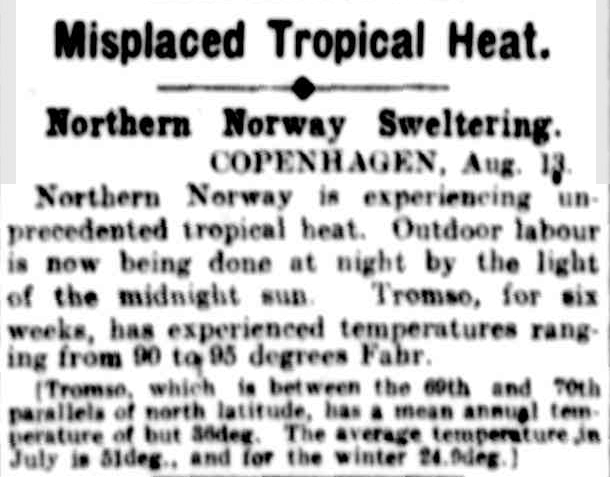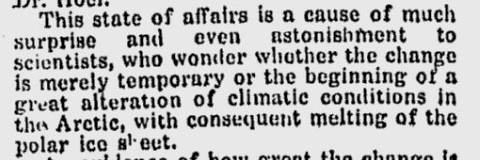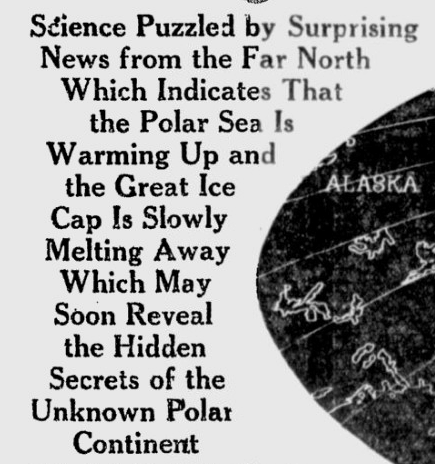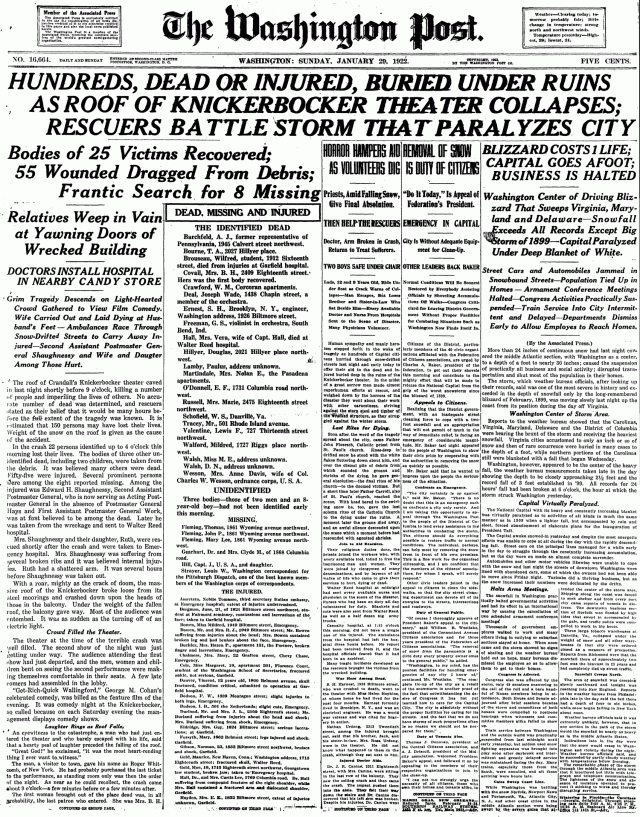Jim Hansen offers fiction as fact
GISS reports that the average temperatures in Tromso, Norway during July and August, 1922 – were a cool 14.8 and 11.9 C.
But a newspaper report from the same summer shows extremely hot temperatures.

Note: "Tromso, for six weeks, has experienced temperatures ranging from 90 to 95 degrees Fahrenheit"
More HERE (See the original for links, more graphics etc.)
A Glowing Report on Radiation
Ann Coulter publicizes radiation hormesis!
With the terrible earthquake and resulting tsunami that have devastated Japan, the only good news is that anyone exposed to excess radiation from the nuclear power plants is now probably much less likely to get cancer.
This only seems counterintuitive because of media hysteria for the past 20 years trying to convince Americans that radiation at any dose is bad. There is, however, burgeoning evidence that excess radiation operates as a sort of cancer vaccine.
As The New York Times science section reported in 2001, an increasing number of scientists believe that at some level -- much higher than the minimums set by the U.S. government -- radiation is good for you. "They theorize," the Times said, that "these doses protect against cancer by activating cells' natural defense mechanisms."
Among the studies mentioned by the Times was one in Canada finding that tuberculosis patients subjected to multiple chest X-rays had much lower rates of breast cancer than the general population.
And there are lots more! A $10 million Department of Energy study from 1991 examined 10 years of epidemiological research by the Johns Hopkins School of Public Health on 700,000 shipyard workers, some of whom had been exposed to 10 times more radiation than the others from their work on the ships' nuclear reactors. The workers exposed to excess radiation had a 24 percent lower death rate and a 25 percent lower cancer mortality than the non-irradiated workers.
Isn't that just incredible? I mean, that the Department of Energy spent $10 million doing something useful? Amazing, right?
In 1983, a series of apartment buildings in Taiwan were accidentally constructed with massive amounts of cobalt 60, a radioactive substance. After 16 years, the buildings' 10,000 occupants developed only five cases of cancer. The cancer rate for the same age group in the general Taiwanese population over that time period predicted 170 cancers.
The people in those buildings had been exposed to radiation nearly five times the maximum "safe" level according to the U.S. government. But they ended up with a cancer rate 96 percent lower than the general population.
Bernard L. Cohen, a physics professor at the University of Pittsburgh, compared radon exposure and lung cancer rates in 1,729 counties covering 90 percent of the U.S. population. His study in the 1990s found far fewer cases of lung cancer in those counties with the highest amounts of radon -- a correlation that could not be explained by smoking rates.
Tom Bethell, author of the "Politically Incorrect Guide to Science," has been writing for years about the beneficial effects of some radiation, or "hormesis." A few years ago, he reported on a group of scientists who concluded their conference on hormesis at the University of Massachusetts by repairing to a spa in Boulder, Mont., specifically in order to expose themselves to excess radiation.
At the Free Enterprise Radon Health Mine in Boulder, people pay $5 to descend 85 feet into an old mining pit to be irradiated with more than 400 times the EPA-recommended level of radon. In the summer, 50 people a day visit the mine hoping for relief from chronic pain and autoimmune disorders.
Amazingly, even the Soviet-engineered disaster at Chernobyl in 1986 can be directly blamed for the deaths of no more than the 31 people inside the plant who died in the explosion. Although news reports generally claimed a few thousand people died as a result of Chernobyl -- far fewer than the tens of thousands initially predicted -- that hasn't been confirmed by studies. Indeed, after endless investigations, including by the United Nations, Manhattan Project veteran Theodore Rockwell summarized the reports to Bethell in 2002, saying, "They have not yet reported any deaths outside of the 30 who died in the plant."
Even the thyroid cancers in people who lived near the reactor were attributed to low iodine in the Russian diet -- and consequently had no effect on the cancer rate.
Meanwhile, the animals around the Chernobyl reactor, who were not evacuated, are "thriving," according to scientists quoted in the April 28, 2002 Sunday Times (UK).
Dr. Dade W. Moeller, a radiation expert and professor emeritus at Harvard, told The New York Times that it's been hard to find excess cancers even from Hiroshima and Nagasaki, particularly because one-third of the population will get cancer anyway. There were about 90,000 survivors of the atomic bombs in 1945 and, more than 50 years later, half of them were still alive. (Other scientists say there were 700 excess cancer deaths among the 90,000.)
Although it is hardly a settled scientific fact that excess radiation is a health benefit, there's certainly evidence that it decreases the risk of some cancers -- and there are plenty of scientists willing to say so. But Jenny McCarthy's vaccine theories get more press than Harvard physics professors' studies on the potential benefits of radiation. (And they say conservatives are anti-science!)
I guess good radiation stories are not as exciting as news anchors warning of mutant humans and scary nuclear power plants -- news anchors who, by the way, have injected small amounts of poison into their foreheads to stave off wrinkles. Which is to say: The general theory that small amounts of toxins can be healthy is widely accepted --except in the case of radiation.
Every day Americans pop multivitamins containing trace amount of zinc, magnesium, selenium, copper, manganese, chromium, molybdenum, nickel, boron -- all poisons.
They get flu shots. They'll drink copious amounts of coffee to ingest a poison: caffeine. (Back in the '70s, Professor Cohen offered to eat as much plutonium as Ralph Nader would eat caffeine -- an offer Nader never accepted.)
But in the case of radiation, the media have Americans convinced that the minutest amount is always deadly.
Although reporters love to issue sensationalized reports about the danger from Japan's nuclear reactors, remember that, so far, thousands have died only because of Mother Nature. And the survivors may outlive all of us over here in hermetically sealed, radiation-free America.
SOURCE
A year of extreme weather events
No. Not 2011, the year 1922
1922 set the record for the hottest temperature ever recorded. 136F in Libya. It also saw record heat in the Arctic, massive typhoons, huge floods and snowstorms. Joe Romm would have been hysterical at 310 ppm CO2.

Eastern Arctic didn’t freeze during the winter

Glaciers disappeared

The Ohio River flooded 54 feet deep.








SOURCE
Comment on the "Climate Change Review" by economist Ross Garnaut -- generated by Garnaut for the Leftist Australian government
A radio interview from Australia: Chris Smith is joined by Professor Ian Plimer. I hope Americans can understand the broad Australian accents. Point of information: When Smith mentions "cockies", he is using a slang term for farmers
Warmist icon bites the dust
Snow slowly building on Mount Kilimanjaro -- but the Warmists talk as if it were still melting away. Reality is optional to them
Standing as the highest mountain in Africa, Mount Kilimanjaro is slowly regaining its snow after several years of drought in East Africa and the effects of climate change in African continent.
The snow is slowly mounting on the top point of the mountain, giving new hopes to Mount Kilimanjaro environmental watchdogs and tourists that the mountain may not lose its beautiful ice cap as scientists predicted.
Covered in mist most of the day, Mount Kilimanjaro is the most tourist attractive site in Tanzania, pulling in tens of thousands of tourists each year. The snow, which once disappeared in some parts of the mountain is mounting slowly, giving a beautiful view of the Kibo peak.
A visit by our Tanzania eTurboNews reporter to Mount Kilimanjaro's slopes proved that there were changes on the mountain snow, which has been covering some parts of the mountain where once the ice had melted.
Standing freely and majestically with its snow gleaming in the sun, Mount Kilimanjaro is in great danger of losing its eye-catching glaciers. The mountain is located some 330 kilometers and three degrees (3 degrees) south of the equator.
Mount Kilimanjaro is an awesome and magnificent peak in Africa and one of the leading single free-standing mountains in the world. It is composed of three independent peaks - Kibo, Mawenzi, and Shira - covering a total area of 4,000 kilometers.
The snow-capped Kibo with permanent glaciers covering its entire peak is the highest at 5,895 meters high and is the most attractive site, pulling in over 40,000 foreign and local tourists per year.
Mount Kilimanjaro was formed some 750,000 years ago and the present features were completely formed in the past 500,000 years after a number of upheavals and tremors, which also caused the formation of 250 volcanic hills and crater lakes including magnificent Lake Chala on its southern slopes.
The mountain is the leading tourist attraction in Tanzania due to its beautiful features and its geological setup. Global warming effects are being felt in most parts of Africa with great impacts on tourist sites including Tanzanian wildlife parks and Mount Kilimanjaro's ecosystem.
Environmentalists warn that this highest peak in Africa could lose its ice cover and glaciers between 2018 and 2020 unless global campaigns to save the mountain’s ecology are taken.
More HERE
Germany: Is Environmentalism Really Working?
They obediently did the bidding of the Fascists and now they are obediently doing the bidding of the eco-Fascists -- again with destructive results. They are again a warning to us all
As usual, ordinary Germans were to blame. Everything had been prepared for the green revolution: fresh supplies and new signs at the gas stations, and the refinery depots were full to the brim with the new wonderfuel. But then drivers turned their backs on the new era. They didn't want to buy E10, a blend of ethanol and gasoline, even through it cost almost 10 cents less per liter than conventional gas.
"It's annoying but there's no question of stopping the sale of E10," said Environment Minister Norbert Röttgen. E10, Röttgen said with a hint of threat in his voice, was a milestone of German climate control policy.
When it comes to the environment these days, all other interests must take a back seat, including possible engine damage from E10. After all, the United Nations has proclaimed that ensuring environmental sustainability is one of its "millennium goals," and greater importance is assigned to climate negotiations among the big industrial nations than to economic summits these days.
All the serious political parties devote large parts of their policy programs to environmental policy. In the coalition deal between Chancellor Angela Merkel's conservatives and the pro-business Free Democrats, protecting the climate comes ahead of education and internal security in the list of policy priorities. The government is as committed to promoting the development of electric cars as it is to expanding renewable energies and protecting fish stocks in German rivers.
There is no issue that produces such unanimity among the parties. A proposal to increase tax credits for employees led to weeks of political debate, while the 2009 European Union ban on conventional light bulbs was approved without a single debate in parliament. As soon as the word environment is mentioned in any policy initiatives, all discussion becomes redundant.
Great Crested News and 50 Million Euros
And no price seems too high. Germany even spends tens of millions of euros on redirecting roads or building tunnels to protect animal species. Last August, for example, a four kilometer long, €50 million tunnel was approved for a highway in the state of Hesse. The reason? A colony of great crested newts had to be protected.
Germans usually obediently go along with environmental measures, in fact they're a model people when it comes to green living. They carefully sort their rubbish, take their bottles back to the supermarket and put their batteries in special containers. When they were told to have carbon filters fitted to their cars, they did so without complaining. And of course they're at the forefront when it comes to attaching solar panels to their roofs or insulating their homes.
Germans only rarely question environmental policies. The light bulb ban was one example. Most didn't see the need to scrap conventional bulbs when the simplest way to save electricity was just to turn off the light. And Germans have been unusually stubborn about the biofuel E10 -- the name refers to the 10 percent ethanol admixture. They would prefer to pay a few more cents per liter of gas than put their car engines at risk.
Many haven't yet fully realized that E10 is an ecological swindle. People who want to help the environment shouldn't use it. Nine large European environmental associations recently conducted a joint study which concluded that the bottom line impact of the fuel on the environment is negative. Rainforests are being clear-cut in Brazil and Borneo to make room for sugarcane and oil palm cultivation. At the same time there's a shortage of arable land for food production, which is leading to the threat of famine in parts of the world. Last year, the price of grain rose sharply in the global market.
A single full tank of bio-ethanol uses up as much grain as an adult can eat in a whole year. In order to cover the German requirement for biofuel, an arable area of around one million hectares would be needed. That is four times the size of the south-western German state of Saarland, which would need to be fertilized, treated with pesticides and intensively farmed. Environmental groups say that across Europe, farming for biofuels would create up to 56 million tons of additional greenhouse gases -- an environmental crime they say must be stopped immediately.
Diminishing Utility
But it's too late for that. Farming and industry have already made the conversion. Germany has devoted huge tracts of farmland to producing maize (for biogas), rapeseed (for biodiesel) and sugar beet and wheat (for biopetrol).
Not everything that looks green serves the environment. The ecological principle of proceeding with care doesn't seem to apply to environmental policy. The more, the better, seems to be the principle. No one is calculating whether all the billions being invested in protecting the environment are actually being spent wisely. Ordinary citizens can't judge it and many experts have no interest in shedding any light on this aspect because their livelihoods are at stake.
A large amount of money flows into studies, risk assessments and providing seals of approval. In many cases, a closer look at environmental measures reveals that they're expensive and don't have much effect. German environmental standards are so high already that it would require an enormous expense to achieve further improvements -- especially in comparison with less developed nations such as China, India or the former Eastern bloc states.
In economics, it's called the law of diminishing marginal utility. The first glass of water you drink will help a lot to quench your thirst. The second will help a little less and so on. By the 10th glass you will be feeling unpleasantly full or even sick. That's the worst aspect: some major environmental policies aren't just ineffective -- they are counterproductive.
A novel problem with Water Conservation
The Germans are obsessed with saving water. You won't find many countries north of the Sahara that are as water-conscious as Germany. They save water while washing dishes (a modern dishwashing machine uses only six liters per cycle), while going to the toilet (many toilets have a setting that allows only a brief flush), and even when washing their cars.
The Environment Ministry recommends that people turn off the tap while they're brushing their teeth. Saving water, the ministry's web page strongly hints, helps poor countries to irrigate their paddy fields. EU authorities are considering setting water flow-through limits in shower heads.
Yet Germany is one of the world's most water-rich countries -- it could theoretically consume five times more water than it does now. Furthermore, it's impossible to transport tap water over thousands of kilometers, so German thrift don't help Vietnamese rice farmers one bit.
And water conservation in Germany can be harmful -- particularly when it comes to the sewage systems beneath German cities. The lack of waste water flowing through the canalization means that fat, faeces and discarded food aren't getting flushed out enough, and are corroding the walls. To compensate, utilities are forced to pump hundreds of thousands of liters of fresh water through the system to keep it operable.
The result, not surprisingly, are higher water bills. And consumers respond to those higher bills by saving even more water. Paradoxically, the vicious cycle can only be broken if consumers start using more water.
Mercurial Light
The light bulb did its job for 130 years, banishing darkness, making the streets safer and comforting people in the dead of night. Until recently, no one would have thought that this everyday object posed such a major environmental threat that it must be banned.
Yet as of Sept. 1, 2009, all 100-watt bulbs vanished from European Union store shelves. A year later, it was the turn of 75-watt bulbs. This year, 60-watt bulbs will go the way of the dodo bird.
Many people already miss them. The energy-saving bulbs that replaced them emit blue light and induce stress because they disrupt the body's production of the sleep hormone melatonin. In addition, they contain mercury -- to the point that consumers are advised not to use them in children's rooms.
In response, many Germans have stockpiled conventional light bulbs in silent protest. They feel the ban on conventional light bulbs makes no sense -- and they're right. The energy-saving bulb is a pretty dirty affair if one takes a closer look at the production process. Eighty percent of the bulbs are made in China where safety standards are so lax that many workers suffer from mercury poisoning. In Germany, the bulbs are classified as special waste and the poisonous substance they contain has to be dumped in underground sites.
Furthermore, the new bulbs don't live up to their promise regarding energy efficiency either. When the magazine Ökotest tested an array of the bulbs recently, half of them didn't last longer than 6,000 hours, well below EU estimates of 10,000 hours, Indeed, it was found that the larger estimate applies only to continuous use. Switching the new bulbs on and off, it would seem, isn't good for them.
The frequency with which environmental policies backfire should give pause for thought. Biofuels were meant to protect the environment and combat global warming -- in fact it destroys rainforests and causes greater CO2 emissions than conventional fuel.
Saving water was meant to protect natural resources, but it just drives up water bills. Banning the light bulb was seen as a milestone on the path to carbon neutral living in Europe -- but China has been cranking up its mercury production to satisfy demand for the alternative energy saving bulbs.
In the fight to protect the environment, it may be time to pause and ask oneself: what is really helping, and what isn't? And to admit at times: sorry, we were wrong. But it doesn't work like that. Environmentalism knows no doubt. The idea is never wrong, the problem is always in the implementation.
And so it will continue. Additional rubbish containers will be introduced, for different types of rubbish. The EU will ban the stand-by function on electronic appliances to reduce energy consumption -- even though engineers know this reduces product lifespans.
At some point, only electrical cars will fulfil environmental requirements, but the electricity will have to come from somewhere -- maybe French or Czech nuclear power stations?
Ordinary people will put up with all this patiently, what else can they do? It all serves the environment, and no one can object to that.
Much more HERE
***************************************
For more postings from me, see DISSECTING LEFTISM, TONGUE-TIED, EDUCATION WATCH INTERNATIONAL, POLITICAL CORRECTNESS WATCH, FOOD & HEALTH SKEPTIC, GUN WATCH, AUSTRALIAN POLITICS, IMMIGRATION WATCH INTERNATIONAL and EYE ON BRITAIN. My Home Pages are here or here or here. Email me (John Ray) here. For readers in China or for times when blogger.com is playing up, there are mirrors of this site here and here
*****************************************






 Jim Hansen and his twin
Jim Hansen and his twin


No comments:
Post a Comment